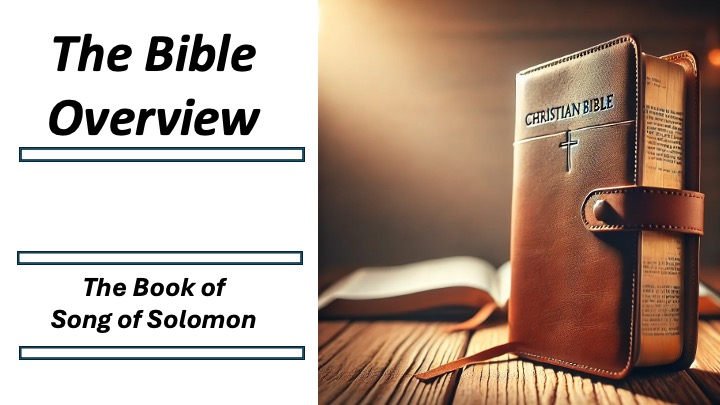Bible Overview Song of Songs
Mike Ervin

This represents a comprehensive overview of the Song of Songs, also known as the Song of Solomon, covering its authorship, date, main themes, chapter summaries, and its importance.
1. Authorship of the Song of Songs
Traditional View
• Attribution to Solomon: The opening verse attributes the work to Solomon: “The Song of Songs, which is Solomon’s.” This led to the traditional belief that King Solomon authored the text.
Modern Scholarly View
• Anonymous Composition: Scholars widely agree that the Song of Songs was not written by Solomon but by an unknown author.
• Linguistic and Cultural Indicators: The language and style suggest a post-exilic composition, possibly around the 3rd century BCE.
2. Date of Authorship
Traditional View
• Solomonic Era: Based on the superscription, traditional views date the composition to the 10th century BCE, during Solomon’s reign.
Modern Scholarly View
• Post-Exilic Period: Linguistic evidence, such as vocabulary and syntax, points to a later date, possibly around the 3rd century BCE.
3. Main Themes
• Celebration of Love: The poem celebrates human love and desire, presenting a dialogue between lovers.
• Nature Imagery: Extensive use of natural metaphors and pastoral imagery to describe beauty and affection.
• Search and Longing: Themes of seeking and yearning, reflecting the lovers’ deep desire for union.
• Joy and Delight: Emphasis on the joy and delight found in mutual affection and physical attraction.
4. Chapter Summaries
Chapter 1: Introduction and Expressions of Love
• Verses 1-4: Introduction and the woman’s longing for her lover.
• Verses 5-11: Exchange of compliments between the lovers.
• Verses 12-17: Imagery of fragrances and nature to describe their affection.
Chapter 2: Mutual Admiration and Invitation
• Verses 1-7: Expressions of beauty and love’s delight.
• Verses 8-17: The woman’s invitation to enjoy the springtime together.
Chapter 3: Dreams and Royal Imagery
• Verses 1-5: The woman’s dream of searching for her lover.
• Verses 6-11: Description of Solomon’s royal procession.
Chapter 4: Praise of the Beloved’s Beauty
• Verses 1-7: Detailed admiration of the woman’s beauty.
• Verses 8-15: Invitation to come away and enjoy love.
• Verse 16: The woman’s response, welcoming her lover.
Chapter 5: Separation and Reunion
• Verses 1-8: The woman’s dream of losing and seeking her lover.
• Verses 9-16: Description of the man’s physical attributes.
Chapter 6: Reunion and Admiration
• Verses 1-3: Reunion of the lovers.
• Verses 4-10: The man’s praise of the woman’s beauty.
• Verses 11-13: Imagery of a dance, celebrating love.
Chapter 7: Expressions of Desire
• Verses 1-9: The man’s admiration and desire for the woman.
• Verses 10-13: The woman’s invitation to the countryside.
Chapter 8: Affirmation of Love
• Verses 1-4: Expressions of longing and affection.
• Verses 5-7: Reflections on the power and permanence of love.
• Verses 8-14: Concluding affirmations and commitments.
5. Importance of the Book
• Literary Significance: Renowned for its poetic beauty and rich imagery.
• Theological Interpretations: Allegorically interpreted in both Jewish and Christian traditions to represent the relationship between God and His people.
• Cultural Impact: Influenced art, music, and literature, inspiring various adaptations and references.
In summary, the Song of Songs is a unique biblical text that celebrates human love and has been subject to diverse interpretations, reflecting its depth and enduring appeal.